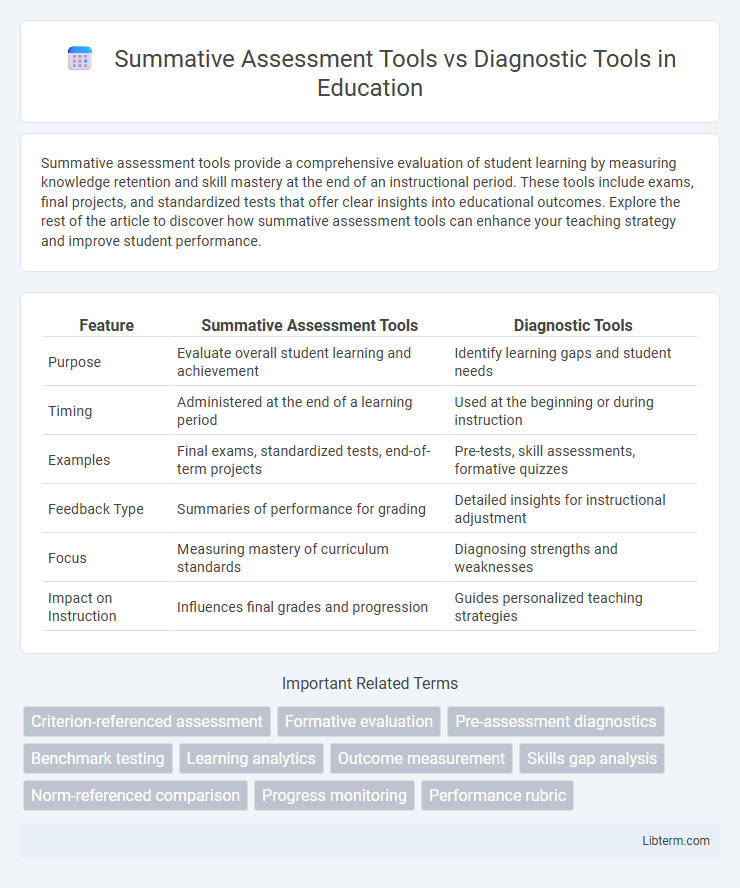Summative assessment tools provide a comprehensive evaluation of student learning by measuring knowledge retention and skill mastery at the end of an instructional period. These tools include exams, final projects, and standardized tests that offer clear insights into educational outcomes. Explore the rest of the article to discover how summative assessment tools can enhance your teaching strategy and improve student performance.
Table of Comparison
| Feature | Summative Assessment Tools | Diagnostic Tools |
|---|---|---|
| Purpose | Evaluate overall student learning and achievement | Identify learning gaps and student needs |
| Timing | Administered at the end of a learning period | Used at the beginning or during instruction |
| Examples | Final exams, standardized tests, end-of-term projects | Pre-tests, skill assessments, formative quizzes |
| Feedback Type | Summaries of performance for grading | Detailed insights for instructional adjustment |
| Focus | Measuring mastery of curriculum standards | Diagnosing strengths and weaknesses |
| Impact on Instruction | Influences final grades and progression | Guides personalized teaching strategies |
Understanding Summative Assessment Tools
Summative assessment tools evaluate student learning by measuring knowledge retention and comprehension at the end of an instructional period, often through exams, final projects, or standardized tests. These tools provide quantitative data to determine overall academic achievement and inform grading decisions. Understanding summative assessment tools is crucial for curriculum planning and identifying areas where instructional strategies succeeded or need improvement.
What Are Diagnostic Assessment Tools?
Diagnostic assessment tools identify students' existing knowledge gaps and learning difficulties by analyzing their strengths and weaknesses in specific subject areas. These tools provide detailed insights that enable educators to tailor instruction and interventions effectively for improved learning outcomes. Common examples include pre-tests, skill inventories, and error analysis assessments designed to pinpoint problem areas before further instruction.
Key Differences: Summative vs Diagnostic Tools
Summative assessment tools measure overall student learning outcomes and performance at the end of an instructional period, using tests, final projects, or standardized exams to evaluate mastery of content. Diagnostic assessment tools identify students' strengths, weaknesses, and learning gaps early in the learning process through pre-tests, quizzes, or skill inventories to guide targeted interventions. The key difference lies in summative tools focusing on outcome evaluation, while diagnostic tools emphasize identifying specific learning needs for personalized instruction.
Purposes of Summative Assessments
Summative assessment tools are designed to evaluate student learning at the end of an instructional period by measuring overall achievement, proficiency, or mastery of specific learning objectives. These assessments, such as final exams, standardized tests, and end-of-term projects, provide critical data for assigning grades and determining curriculum effectiveness. Their primary purpose is to summarize learning outcomes and inform decisions related to student progression and instructional adjustments.
Goals of Diagnostic Assessments
Diagnostic assessments aim to identify students' strengths, weaknesses, knowledge gaps, and learning needs to tailor instruction effectively. These tools provide detailed insights into cognitive processes and skill levels, enabling targeted intervention and personalized support. Contrastingly, summative assessments evaluate overall learning outcomes at the end of an instructional period without pinpointing specific areas for improvement.
Examples of Summative Assessment Tools
Examples of summative assessment tools include standardized tests, final exams, end-of-term projects, and cumulative portfolios, which measure student learning at the conclusion of an instructional period. These tools evaluate overall achievement and comprehension by providing quantifiable data on student performance. Summative assessments are designed to summarize learning outcomes and inform decisions about grades, mastery, and program effectiveness.
Common Diagnostic Tools in Education
Common diagnostic tools in education include formative quizzes, standardized tests, and observational checklists designed to identify students' learning gaps and skill levels. These tools provide detailed insights into individual strengths and weaknesses, enabling targeted intervention before summative assessments. Effective diagnostic tools often incorporate adaptive technology and data analytics to tailor instruction and enhance student outcomes.
Advantages and Limitations of Summative Assessments
Summative assessment tools provide comprehensive evaluations of student learning outcomes at the end of instructional periods, offering clear data on achievement levels and curriculum effectiveness. Their main advantages include standardized measurement, accountability for educators, and the ability to inform future curriculum design. Limitations involve limited insights into individual learning processes, reduced opportunities for timely feedback, and potential stress induction affecting student performance and motivation.
Benefits and Challenges of Diagnostic Assessments
Diagnostic assessment tools provide detailed insights into learners' strengths and weaknesses, enabling targeted interventions that improve individual learning outcomes. These assessments uncover specific skill gaps early, promoting personalized instructional strategies, though challenges include time-consuming analysis and the need for expert interpretation to avoid misdiagnosis. Despite these complexities, diagnostic assessments support data-driven decision-making and foster continuous learning improvements.
Choosing the Right Assessment Tool for Your Needs
Selecting the appropriate assessment tool depends on your specific goals, as summative assessment tools evaluate overall learning outcomes, while diagnostic tools identify strengths and weaknesses for targeted intervention. Summative assessments often include standardized tests or final projects that measure cumulative knowledge, whereas diagnostic tools utilize quizzes, pre-tests, or performance tasks that pinpoint individual learning gaps. Understanding the purpose of assessment helps educators or trainers implement tools that effectively guide instruction and improve learning outcomes.
Summative Assessment Tools Infographic

 libterm.com
libterm.com